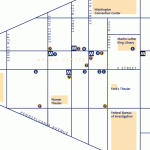Open City – 1999
In .
Open City is a site-specific telephone installation that seeks to revive the street as a space for cultural reflection and civic interaction. The installation piggybacks on privately owned cell phones and the existing network of public pay phones in the region of downtown Washington D.C. bounded by G Street on the north, 10th Street on the east, E Street on the south, and 14th Street on the west. Callers dial in and can select from a menu of recordings on the subject of technology, public space and civic identity. Open City is a site-specific telephone installation that seeks to revive the street as a space for cultural reflection and civic interaction. The installation piggybacks on privately owned cell phones and the existing network of public pay phones in the region of downtown Washington D.C. bounded by G Street on the north, 10th Street on the east, E Street on the south, and 14th Street on the west. Callers dial in and can select from a menu of recordings on the subject of technology, public space and civic identity.
Participants may leave messages and are encouraged to use telephones to document, in audio form, the present state of the neighborhood. They may choose to record ambient sounds, conversation, descriptions or stories about various locations, or their own thoughts on the relationship between urban design and civic identity. Selected messages have been integrated into voicemail greetings and archived on the project web site. Background
Washington DC, as our nation's capital, is a city that belongs to the people. The original design of the city expressed this idea by encouraging public gathering in wide streets and open spaces, intended to "symbolize a government that is accessible to its people" (1). The design of grand avenues connecting major landmarks was intended to ease movement through the city and create vistas between important locations, such that even great distances would appear diminished by the illusion of proximity.
Much has changed since this original design was made, though one concern has remained constant: the desire to reduce the distance between people in communication. This desire has been addressed by designs ranging from architecture and urban planning to cell phones, pagers, walkmans, and portable computers complete with mobile internet access. Contemporary urban spaces are characterized not just by the arrangement of architecture and infrastructure, but also by the parallel design and use of communications technologies.
Open City invites people to engage in public dialog about citizenship in the contemporary urban landscape--a landscape that is defined as much by telecommunications networks as by brick and mortar.
© Teri Rueb 1999
References:
The City in History: its origins, its transformations, and its prospects Lewis Mumford
New York: Harcourt, Brace & World, 1961
The City Reader
ed. Richard T. LeGates and Frederick Stout
London; New York: Routledge, 1997
Crowds and Power
Elias Canetti, trans. Carol Stewart
New York: Viking Press, 1962
Extending the Legacy: planning America's capital for the 21st century
US: National Capital Planning Commission, 1995
The Geography of Nowhere
James Howard Kunstler
New York: Touchstone, 1993
Acknowledgments:
Many thanks to Laura McGough, Nadine Gabai-Botero, The WPA/Corcoran, The Downtown DC Building Improvement District, Museums Washington Magazine, and Mercedes-Benz.

